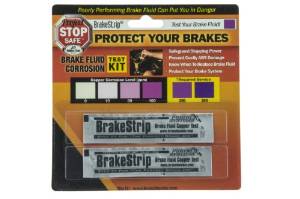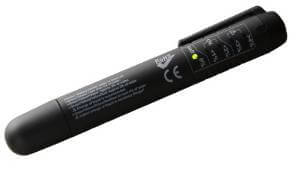A brake fluid flush is not a scam
A brake fluid flush is a legitimate and recommended service
No. A brake fluid flush is a critical maintenance service to prevent internal brake system corrosion.
What goes bad in brake fluid?
The base chemical in brake fluid is glycol ether. DOT 3 fluid is approximately 80% glycol ether and DOT 4 is made with 50 to 65% glycol ether base with 20-30 % Borate Ester to resist boiling. The balance of brake fluid is pH balancing and anti-corrosion additives.
Glycol ether does not wear out or go bad, but the additives do wear out over time and especially as the fluid absorbs moisture. All brake fluid absorbs moisture over time
The effects of water on brake fluid
Water in brake fluid reduces its boiling point and decreases your braking ability, especially in hard braking situations that create the most heat. But water in brake fluid accelerates the degradation of the anti-corrosion and pH balancing additives, leaving the system open to internal corrosion.
That internal corrosion can damage steel brake lines, calipers, wheel cylinders, and ABS valves. In other words, what you save by not performing a brake fluid flush is nothing compared to the cost of replacing corroded brake lines and other major components.
How does water get into brake fluid?
Brake fluid is hygroscopic (water loving), but the hydraulic system is a sealed system. So how does water get in? Three ways:
1) If the brake fluid is topped off with fluid that has been open to the air, that fluid will carry water into the system.
2) If the cap from the master cylinder reservoir is left off, the brake fluid in the reservoir will adsorb water.
3) As the caliper pistons and wheel cylinder pistons move out and in, the pores in the pistons can carry ambient moisture into contact with the brake fluid. Over time, brake fluid can accumulate up to a 4-6% water concentration.
Brake fluid color is NOT an indication of its condition
Color is NOT always a proper indicator of brake fluid condition. It’s true that fresh brake fluid has a honey-like color. But in some vehicles, fresh brake fluid can turn dark in a matter of just weeks after a complete flush. Don’t let a shop convince you to get a brake fluid flush based on the color of the fluid. Insist that they test it, or test it yourself with the items below.
When to perform a brake fluid change?
Some carmakers list a mileage/time recommendation to change brake fluid like every 24,000-miles or 2-years, whichever comes first. But other carmakers don’t list any recommendation for performing a brake fluid change.
General Motors, Ford, and Chrysler don’t include brake fluid flush recommendations in their maintenance guides. General Motors believes the extra additives in their factory fill of a Delco Supreme 11 DOT 3 brake fluid makes it a lifetime fluid. Plus, GM uses a different type of rubber brake hose that reduces moisture infiltration, so GM doesn’t consider brake fluid contamination to be a problem.
However, many import car makers do recommend brake fluid changes for preventive maintenance at specific time/mileage intervals:
Acura: 36 months
Audi: 24 months
BMW: 24 months, or when indicated by Service Inspection Indicator
Honda: 36 months
Jaguar: 24 months all models except 2009 XF (36 months)
Land Rover: 36 months
Lexus: 36 months or 30,000 miles, whichever comes first
Mercedes-Benz: 24 months
MINI 24 months
Saab: 48 months (all models except 9-7X)
Smart: 24 months or 20,000 miles, whichever comes first
Subaru: 30 months or 30,000 miles (normal service) or 15 months/15,000 miles (severe service)
Suzuki: 24 months or 30,000 miles, whichever comes first (Forenza & Reno), 60 months or 60,000 miles (Grand Vitara and SX4)
Sprinter van 24 months
Volkswagen: 24 months (New Beetle, City Gold, City Jetta), 36 months (all other models except Routan)
Volvo: 24 months or 37,000 miles (Normal), or 12 months (severe service)
How to test brake fluid to see if it requires a change
Brake fluid test strips
When dipped into the brake fluid, the strip changes

Buy a package of brake fluid test strips and test your brake fluid so you don’t get scammed.
color, indicating the level of copper in the fluid. Copper is leached out of the brazing material used to fabricate steel brake lines. As the anti-corrosive additives in brake fluid wear out and the fluid accumulates water, the brew attacks the brake line seams, degrading the interior of the line.
Moisture meter
Moisture meters are simply conductive meters that register the amount of water in the brake fluid.
Rather than perform a brake fluid change based on mileage

Battery-powered brake fluid moisture tester
or time, you may want to perform your own testing to get a more accurate idea of the condition of your brake fluid.
How much is a brake fluid flush?
The entire flushing procedure takes about 30-mins. to 45-mins. Based on a shop labor rate of $125/hour, a typical brake fluid should run between $75 and a maximum of $150 plus the cost of the brake fluid. Brake fluid cost is minimal, usually less than $10. So the overall cost depends on the shop’s hourly labor rate. If the shop wants to charge more than $150 for a brake fluid flush, find a different shop.
©, 2021 Rick Muscoplat
Posted on by Rick Muscoplat